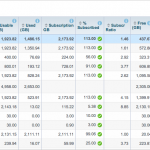
 Like most things at EMC, the OpenStack integration strategy is focused on customer choice. It’s an attempt to meet the customer where they leveraging IT assets, specific workloads, and integration points into all of our products. Additional automation and deeper integration we provided by our software defined storage can control plane software called ViPR. Obviously all of the deep reporting, SRM tools, and storage data protection services will remain and be brought into the OpenStack integration.
Like most things at EMC, the OpenStack integration strategy is focused on customer choice. It’s an attempt to meet the customer where they leveraging IT assets, specific workloads, and integration points into all of our products. Additional automation and deeper integration we provided by our software defined storage can control plane software called ViPR. Obviously all of the deep reporting, SRM tools, and storage data protection services will remain and be brought into the OpenStack integration.
To jump right into EMC integration with OpenStack Cinder, we provide native plug-ins for all of our block storage products, iSCSI Isilon and Scale I/O. Several major distributions such as Rack Space, Red Hat, and Canonical distribute the plug-in for VNX and VMAX, and versions of the Cinder plug-in support fiber Channel are available from Github or the EMC web site. Third parties have written the Cinder plug-ins for Isilon iSCSI and Swift support and iSCSI support for Scale I/O.
 EMC’s recommended approach would be to use the Cinder plug-in for our ViPR storage control-plane product, since through that single plug-in iSCSI and fiber channel support are provided across all our products, as well as object storage support for Swift, S3, and our own Atmos APIs. That plug-in is available from Github and will be coming to the major distributions soon. The advantage of using ViPR especially in fiber Channel environments is that ViPR will automate the zoning and the definition of rich service pools that provide fully automated storage tiers, replication settings, and high availability configuration.
EMC’s recommended approach would be to use the Cinder plug-in for our ViPR storage control-plane product, since through that single plug-in iSCSI and fiber channel support are provided across all our products, as well as object storage support for Swift, S3, and our own Atmos APIs. That plug-in is available from Github and will be coming to the major distributions soon. The advantage of using ViPR especially in fiber Channel environments is that ViPR will automate the zoning and the definition of rich service pools that provide fully automated storage tiers, replication settings, and high availability configuration.
Not only is there a single integration point with the ViPR Cinder plug-in for block storage, but with ViPR data services we bring Swift API and Amazon S3 API support. Finally, ViPR brings this automation support to all consumers of block storage, not only OpenStack but VMware and other virtualized or bare metal hosts.


